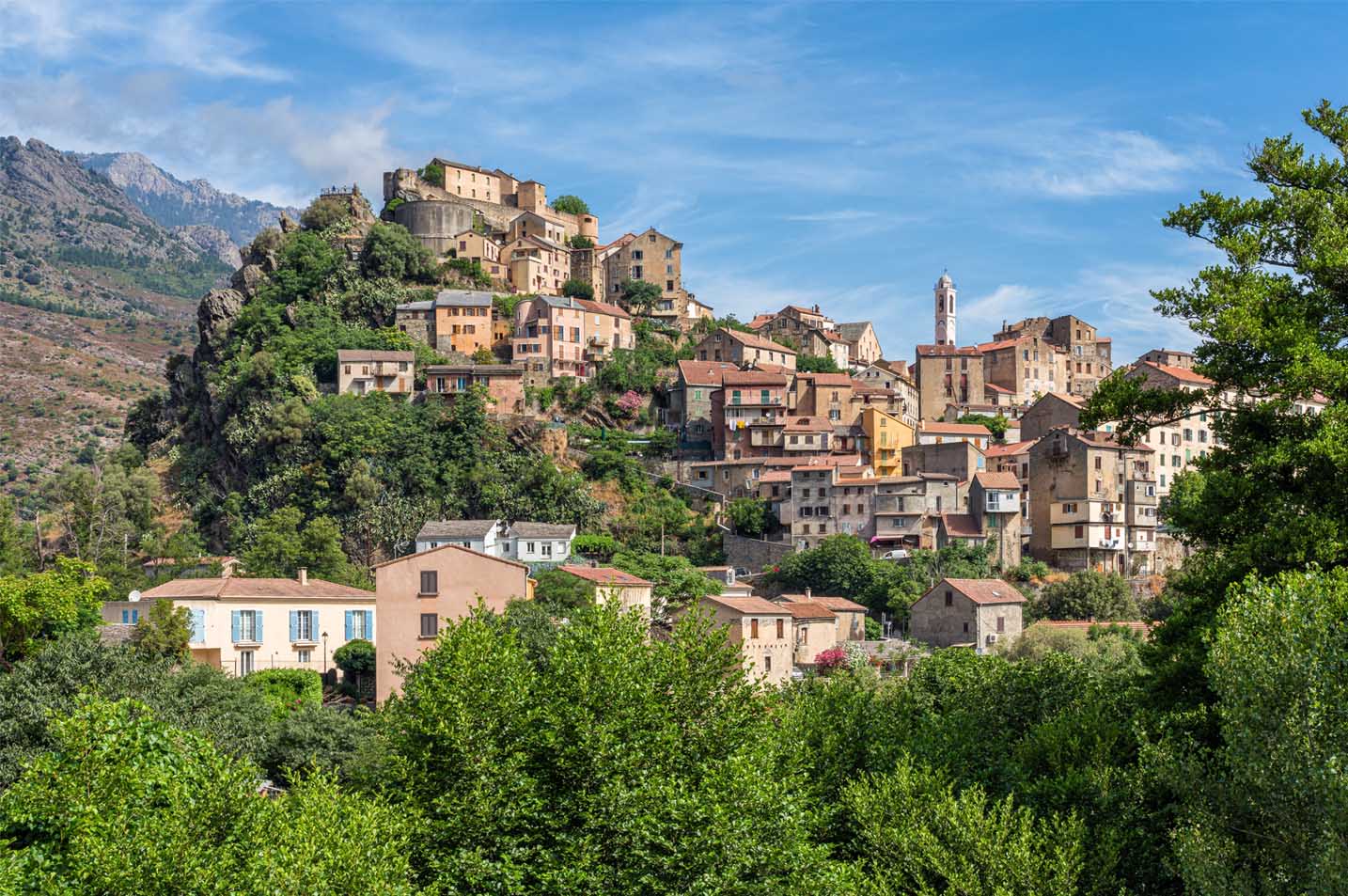
Discovering Cap Corse means immersing yourself in a territory that is wild, unspoiled and steeped in tradition. This peninsula in the north of the island fascinates with the variety of its landscapes , where the mountains plunge into the sea, and with the authenticity of its hilltop villages and secret seascapes.
That said, in three well-thought-out days, it becomes possible to capture the essence of Cap Corse : between panoramic roads, hidden coves and warm encounters, each stage holds its share of surprises. Know that, to make the experience fluid and enriching , it is important to favor slowness, curiosity and listening to the island soul.
Here is a detailed itinerary, punctuated with practical advice and original ideas, to organize an unforgettable trip around Cap Corse in 2025.
Organizing your route: tips for an unforgettable loop
It should be noted that we recommend a tour of Cap Corse in an anti-clockwise direction, starting from Bastia, in order to enjoy the most beautiful lights on the coast. In addition, the route lends itself well to a gentle road trip , punctuated by walks, gourmet breaks and cultural strolls . Here are the key points to prepare your getaway:
- travel the D80 from Bastia to Saint-Florent, via the east coast, the northern tip then the west coast;
- plan stops in emblematic villages (Erbalunga, Centuri, Nonza) and on hidden beaches;
- integrate some short hikes , notably on the customs path;
- book your accommodation in advance, especially during high season;
- alternate maritime experiences (boat trip, snorkeling) and local stops (tasting in the Patrimonio wine estates).
After these recommendations, it must be said that everyone finds a natural rhythm to soak up the unique atmosphere of Cap Corse, between sea and mountains , tradition and modernity .
From Bastia to Macinaggio: first steps on the eastern coast
Your first day begins in the vibrant city of Bastia , which is worth exploring in its own right for its port, citadel, lively streets and panoramic views of the sea. Leaving Bastia via the D64 and then D80 roads , the landscapes gradually open up to reveal the authenticity of Cap Corse.
You’ll then enter a world of balcony villages, secret seascapes, and horizons dotted with Genoese towers. The must-see stops on Day 1 are:
- Erbalunga, a picturesque jewel , renowned for its narrow streets and its pocket-sized port, lively all summer long;
- Pietracorbara , renowned for its wide beach of blond sand and crystal clear water, ideal for a swimming stop;
- Porticciolo and Meria , two peaceful seascapes that invite contemplation, coupled with memories of island history (Genoese bridges, ancient chapels);
- Tomino and Rogliano , hilltop villages offering stunning views of the Bay of Macinaggio.
After a succession of striking panoramas, the day often ends at Macinaggio , a lively marina in season, the perfect starting point for exploring the north of the peninsula.
Furthermore, it should be noted that accommodation in Macinaggio or its surroundings will allow you to enjoy the sweetness of Corsican evenings , between fish restaurants and terraces enlivened by the sea breeze.
The northern tip: hiking and sea, harmony in nature
On the morning of the second day, the light sublimates the north coast of Cap Corse, a privileged territory for lovers of nature, gentle or sporty walks, and magnificent panoramas. From Macinaggio, the famous customs officers’ path winds along the coast, offering exceptional landscapes, a succession of often deserted beaches and coves, and a sensory immersion in the Corsican scrubland.
For lovers of coastal hiking , the customs officers’ trail offers an unforgettable immersion in the heart of the wild landscapes of Cap Corse. Throughout the route, walkers discover unspoiled nature and remarkable heritage at each stage :
- departure from Macinaggio beach , towards Tamarone, then towards the Finocchiarola Islands nature reserve (seabird sanctuary);
- continue towards the chapel of Santa Maria , the cove of Sainte-Marie and the long wild beach of Barcaggio , with the Giraglia lighthouse in sight;
- numerous swimming spots, preserved landscapes and observations of local wildlife along the entire route;
- possibility, in season, of returning by sea shuttle from Barcaggio.
After the walk, you should enjoy the conviviality of the village of Barcaggio , nestled in the hollow of a bay, or continue the adventure towards Tollare and its forgotten marina.
For those who enjoy long circuits , the path continues to Centuri: it crosses cliffs, hamlets and promontories, revealing another face of Cap Corse , wilder and often deserted by the crowds.
From Centuri to Nonza by the west coast: villages and heritage
This third day is the perfect opportunity to get back in the car and travel along the west coast, renowned for its villages clinging to the mountains , its wild coves and its golden light. It must be said that this section reveals a more secret side of Cape Town, full of traditions, conducive to meetings and tasting local products . It is full of authentic villages and emblematic sites, among which:
- Centuri , the leading lobster fishing port, known for its colorful houses, lively marina and renowned restaurants for seafood lovers;
- Morsiglia , with its green schist houses leaning against the cliff, and its peaceful, timeless atmosphere;
- Pino , where generous nature and Genoese history converge;
- the Moulin Mattei , a panoramic viewpoint on both sides of the Cape, ideal for a contemplative stop;
- Canari , Ogliastro and their hamlets, where the pastoral spirit and Corsican traditions continue.
After this succession of villages , the coastal road arrives at Nonza, a fortress perched on a promontory, overlooking its legendary black pebble beach and turquoise waters.
In addition, Nonza offers a perfect last stop: climb the Paoline tower to admire the sunset, stroll through its streets, linger on the terrace of a café or taste the local sweets, such as brocciu doughnuts .
End of the tour: Patrimonio and Saint-Florent, terroir and art of living
Before concluding your tour, it’s worth spending a few hours at the Patrimonio vineyards , whose reputation extends beyond Corsica’s borders. Although the vineyard is primarily known for its white wines, it also produces excellent rosés and muscats. Wine lovers can opt for a wine tasting or simply stop at one of the signposted estates along the D81.
Practical tips and tricks
Discover the secrets of a successful stay in Corsica, between authentic flavors and landscapes . Here are some practical tips and essential tricks to fully enjoy this unique experience:
- book your passage in the estates in season;
- with Corsican-style charcuterie or cheese;
- prefer Saint-Florent for its elegant marina and lively streets;
- do not miss the citadel, the port and the view of the Agriates , accessible by sea excursion.
Before leaving Cap Corse, take the time for a final walk along the quays of Saint-Florent , to stroll through the old town and to experience the gentle art of living that characterizes this corner of Corsica.
After all these discoveries, a feeling of harmony between sea, mountains and culture will stay with each visitor for a long time.
Bonus activities and original alternatives
It is worth noting that Cap Corse can also be explored in other ways: by pleasure boat from Macinaggio or Bastia to admire the coastline from the sea, or even by microlight for a breathtaking view of the island and its landscapes. In addition, each village offers its own cultural events , markets or village festivals, mainly in summer – an excellent opportunity to experience local hospitality.
Finally, for seasoned walkers , numerous small trails (the mill trail in Cagnano, the Centuri sheepfolds, the heritage trails) offer peaceful and confidential alternatives to the classic routes .
Accommodation, catering and transport: prepare your stay well
Choosing your accommodation is essential because it directly influences the atmosphere of your stay. From family campsites to charming hotels and B&Bs, all options are possible. However, during peak season, availability may be limited, so it is strongly recommended to book in advance.
For your meals, the Cap Corse coastline is full of small, friendly restaurants. You can enjoy lobsters, fritters, Corsican specialties, and local wines. Some restaurants even offer huge terraces overlooking the sea, ideal for ending a relaxing day.
For greater freedom of movement, consider renting a car, as public transport is limited in the region. After the summer period, the region reveals a new face, calmer and almost secret, ideal for a return or a timeless stay.
In 2025, Cap Corse remains a mosaic of landscapes, traditions, and powerful emotions, to be explored without haste to grasp its full richness. Three well-planned days are enough to capture its essence, meet its inhabitants, enjoy unspoiled nature, and leave feeling calm, your heart filled with unique memories.
In addition, between maritime heritage , breathtaking panoramas, gourmet discoveries and cultural immersion , this itinerary will enrich each traveler, inviting, upon return, to plan a next stay on the Isle of Beauty .
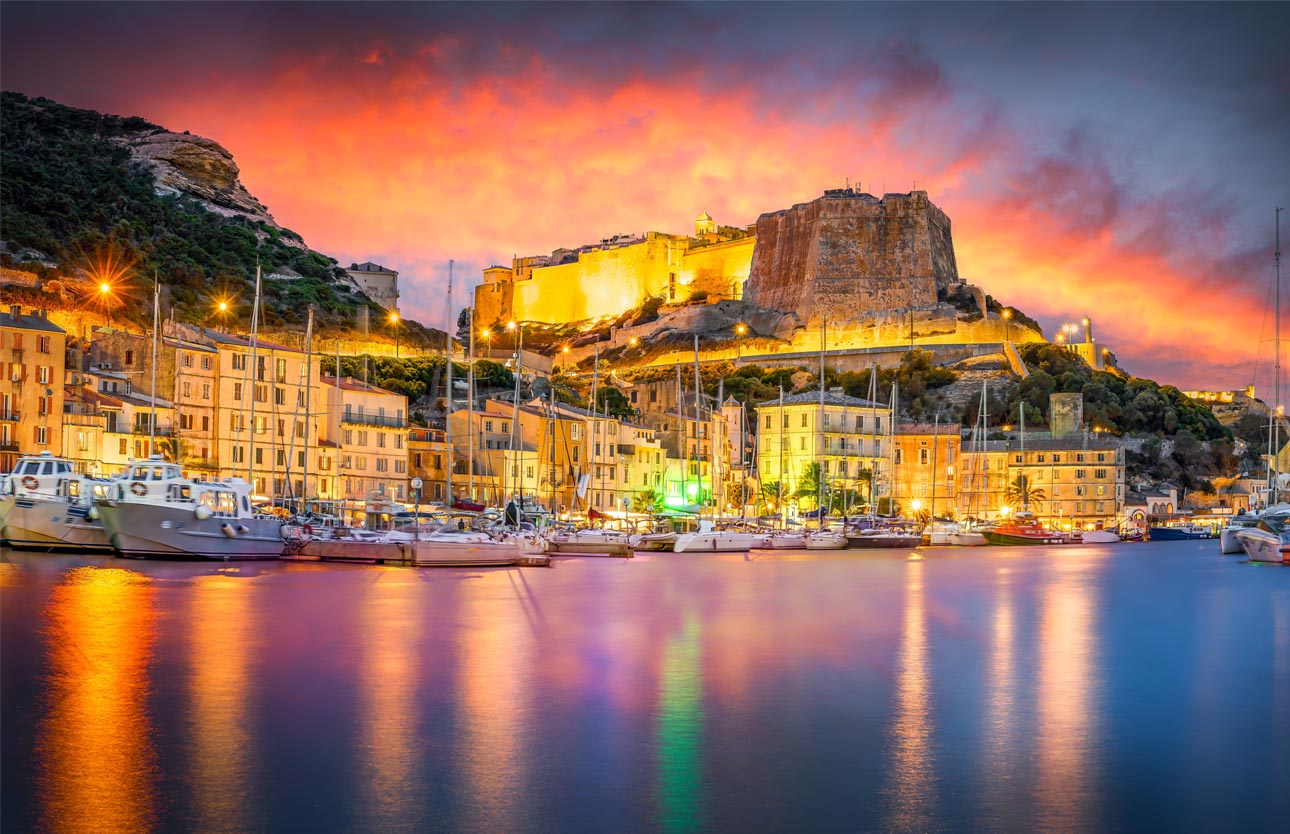
As soon as the sun sets, Corsica transforms , offering a vibrant atmosphere where entertainment, conviviality and culture blend together . The Isle of Beauty reveals an incredible range of nightlife experiences, from renowned festivals to artisan markets, panoramic bars and seaside clubs . The mild climate, the authenticity of the villages and the human richness contribute to a unique nightlife atmosphere.
Every evening, island traditions , music, and a warm welcome invite you to discover new things. It’s important to note that each region has its own unique characteristics, allowing you to enjoy a variety of experiences throughout your stay. Discover below a structured overview of the best Corsican evenings to experience in 2025.
Exploring Corsican nightlife: the essentials to remember
Evenings in Corsica rhyme with diversity, between cultural events and popular festivals . It is worth noting that each town comes alive from the end of the afternoon, offering both major events and more intimate atmospheres. You will meet both visitors who have come to celebrate summer and locals attached to their traditions.
Island Party Classics
Corsica ‘s nightlife is driven by major events and iconic locations. Among the must-sees:
- the major music festivals that punctuate the season;
- panoramic bars and beach clubs , revealing all the beauty of the coasts;
- markets and traditional festivals , reflections of heritage.
After enjoying these moments, nothing is more pleasant than tasting the warm atmosphere of a small village or continuing the evening around a lively table. That said, refinement is always mixed with authentic conviviality, each encounter bringing a new sparkle .
Events and festivals: Corsica comes alive at nightfall
Summer 2025 in Corsica promises a wealth of cultural and festive events , often in the open air. Furthermore, the offering is particularly rich in Haute-Corse as in Corse-du-Sud , with a variety of experiences to be enjoyed in the great outdoors as well as in the heart of historic cities.
Major music and cultural festivals
For your information, the following festivals are among the most anticipated of the season:
- Patrimonio Guitar Nights (July 19-26, 2025) , where international guitarists play under the stars in an exceptional amphitheater setting;
- Porto Latino in Saint-Florent (August 2-5, 2025) , which showcases world music in the famous citadel;
- the Aiò Festival in Ajaccio (July 28-August 2, 2025) , bringing together great voices from the French scene around the greenery of the Casone;
- Corsican and Mediterranean Polar Festival (July 30-August 2, 2025) with its literary meetings and fascinating debates.
However, the magic also happens at more discreet events, such as the free concerts at Jazz in Aiacciu or the open-air readings at the Olmu Festival in Olmeto . It must be said that the diversity of artistic expressions is one of the strong points of the local nightlife.
After a sunset concert, many visitors continue their evening in the bars or lively squares of historic cities , thus prolonging the festive atmosphere of the day.
Village festivals, traditions and night markets
Although Corsica is famous for its large gatherings , village festivals and night markets are just as popular. Each week, a village celebrates its specialty or patron saint with craft stalls, tastings and musical entertainment .
In addition, some markets stay open until midnight all summer long: this is particularly the case in Calvi , where you can stroll among the stalls of regional products, to the melodies of Corsican music or improvised concerts.
After these nighttime strolls , we appreciate even more sitting on a terrace, facing the sea or under the plane trees of a village to enjoy the sweetness of island evenings.
The must-see places for going out in Corsica: atmosphere and diversity
Corsica has a multitude of addresses and places to suit all tastes. Whether you’re looking for a peaceful evening, a lively night out, or a dinner in an exceptional setting , the choice is vast. Each town has its own unique identity around the festival.
Trendy bars, rooftops and trendy places
Here is an overview of the most popular addresses for a successful evening:
- B52 in Bonifacio , a true institution where the electric atmosphere attracts fans of themed evenings, DJs and refined cocktails;
- La Sassa in Nonza , a pearl nestled on the heights offering a breathtaking view and festive evenings to the rhythm of music and the panorama;
- at Tao in Calvi , an emblem of local nightlife in the heart of the citadel, combining elegance and a unique musical experience;
- the Black Sheep in Bastia , where theme evenings attract young and old in a relaxed atmosphere;
- the Conca d’Oro in Saint Florent , a classic for electronic music enthusiasts in Haute-Corse.
Note that in each town, new venues regularly create an event, reinventing Corsican celebrations with the latest trends and seasons. In addition, the presence of numerous wine bars, beach huts, and beach clubs guarantees a varied range of atmospheres every evening.
After enjoying one of these atmospheres, it is common to extend the evening on the beach or join a nearby club to dance until dawn.
Iconic open-air clubs and discos
Corsica is known for its many open-air clubs where you can dance under the stars. The fact is that some establishments are legendary , attracting night owls from all over Europe:
- Via Notte in Porto-Vecchio , the largest open-air nightclub on the continent;
- Blue Moon in Porticcio , modern setting, varied entertainment and high-level DJ programming;
- In Casa and Octopussy in Calvi , famous for their beach parties and cosmopolitan clientele.
Note that these establishments often organize themed evenings and welcome international artists , accentuating the influence of Corsican nightlife.
After a night in one of these legendary addresses, many people enjoy ending the evening with a swim in the sea or breakfast on the terrace at sunrise.
Gourmet evening pleasures and cozy addresses
Gastronomy occupies a central place in Corsican nightlife. In addition to the many traditional restaurants, there is a selection of wine bars, gourmet cellars, and exceptional restaurants, ideal for enjoying local cuisine in a friendly atmosphere.
Seafront dining and sophisticated beach bars
For an unforgettable dinner or an aperitif with friends in a privileged setting, several addresses are worth the detour, such as:
- Sea Lounge ( Palombaggia beach ) , in Porto-Vecchio, where cocktails, lounge music and deckchairs blend harmoniously;
- La Table de la Plage at Domaine de Murtoli, in Sartène , renowned for its signature cuisine and its driftwood decor;
- the Tiki in Saint-Cyprien and Linda Beach in Palombaggia , ideal for tasting seafood during a meal with your feet in the water.
Most of these establishments showcase Corsican cuisine, particularly grilled fish and seafood dishes , combining conviviality and elegance. Attentive service and a musical program create an atmosphere conducive to relaxation or celebration. After dinner, many extend the evening in a club or simply on the beach by lantern light .
Intimate atmospheres and night markets
Corsica offers a variety of evening events, ranging from intimate settings to large-scale outdoor festivities. For an authentic immersion in the Corsican art of living under the stars, you can choose to relax in quieter establishments. Wine bars in Bastia, Ajaccio, and Porto-Vecchio offer acoustic concerts and tastings.
The night markets of Calvi or Porto-Vecchio are perfect for strolling among local producers and artisans in a friendly atmosphere. These delicate and refined experiences rival the charm of large outdoor festivals.
Nighttime activities and original experiences not to be missed
Corsican nightlife isn’t just about partying. While many people are primarily looking for entertainment, the island also offers unusual activities to keep things interesting.
Sky observation evenings and walks under the stars
For memorable evenings in Corsica, the Porto-Vecchio Astronomy Club offers sky observations in Lecci, far from light pollution. These special moments offer a guided exploration of the celestial vault.
In addition, the coastal paths invite you to go for night hikes, allowing you to discover the Corsican coast in a different way, between the scents of the maquis and new sensations.
After these activities, enjoy the lively atmosphere of a night market or the calm of a terrace away from the hustle and bustle to prolong the magic of your evening in Corsica.
Other nighttime activities for all tastes
Corsica offers other nighttime entertainment options to suit all tastes, including open-air concerts and shows held in large squares or ancient cities. The merchants’ “night shows” offer entertainment specially designed for children, creating convivial moments where all generations can come together.
Food lovers can also participate in tasting evenings in cellars and wineries, combining the discovery of local grape varieties with that of authentic Corsican flavors. After enjoying these varied activities, many people discuss the rest of their program with local residents or advisors , who guarantee the best possible experience.
Practical tips for making the most of Corsican nightlife
The quality of your evening depends on a few simple tips : book your tickets in advance for major festivals , use public transport or organise a taxi for late returns, and above all check the programmes locally , as many activities are decided at the last minute in the Corsican spirit.
Please note that some clubs and restaurants may change their opening hours depending on the season or may organize private events . Respecting the local area and traditions is essential to ensure you receive the right welcome. These tips will allow everyone to enjoy a peaceful evening, while respecting the unique atmosphere of Corsica.
After embracing the Corsican night, we often keep a memorable memory of unexpected encounters and suspended moments, between sky, sea and illuminated villages . To prolong the magic, it is not uncommon to go to a beach in the early morning, a last drink under the stars or a boat trip at sunrise .Corsica, in 2025 , shines at night with its cultural events, its renowned restaurants , its night markets, its emblematic clubs and above all by the human richness which characterizes the Isle of Beauty. Whether you are looking for a festive moment, a chic atmosphere or an immersion in the Corsican soul, each night promises a unique memory, always punctuated by warmth, encounters and exceptional moments .
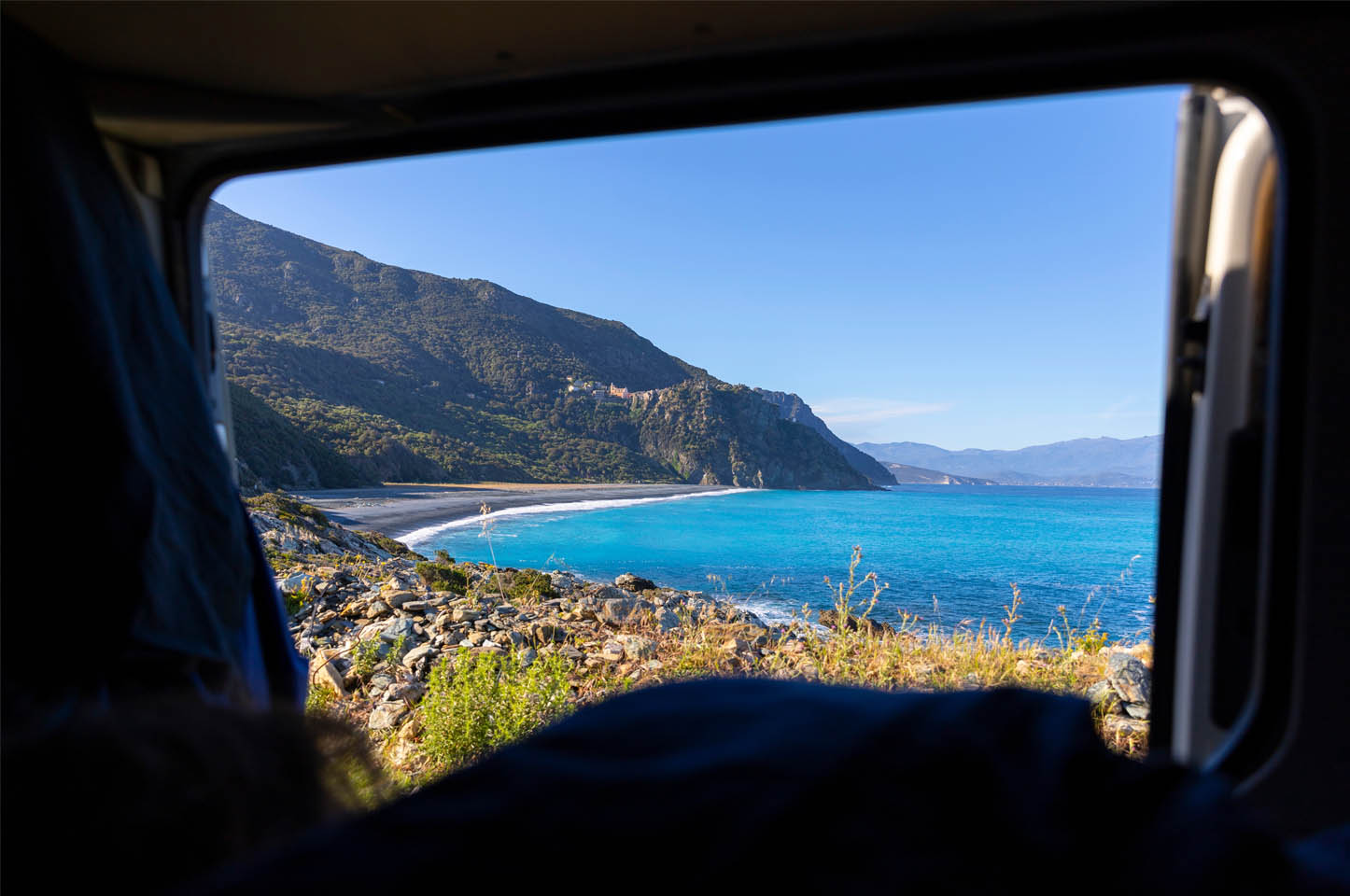
Haute-Corse, an emblematic region of the Isle of Beautyis an ideal playground for motorhome enthusiasts. Its varied landscapes (from fine sandy beaches to rugged mountains) promise a unique experience.
This comprehensive guide features must-see itineraries, practical tips and the best parking areas. Whether you’re a novice or an experienced rider, get ready to discover the authenticity of the villages and the natural beauty of this emotionally rich region!
Must-see motorhome itineraries
Haute-Corse is full of treasures to discover, and motorhoming is undoubtedly the ideal way to explore the region at your own pace. Here are a few itineraries to help you make the most of this part of the island.
The road to Cap Corse
Cap Corse is the peninsula to the north of the island, offering a spectacular route along its rugged coastline. This 130 km itinerary will take you through breathtaking landscapes, between sea and mountains.
Leave Bastia and follow the D80 along the coast. You’ll pass through picturesque villages such as Erbalunga, famous for its small fishing port, or Nonza, perched on a black rock overlooking the sea. Don’t hesitate to stop off at Centuri or Macinaggio, ideal starting points for a hike to the Finocchiarola islands.
It should also be noted that some stretches of road are narrow and winding. So drive carefully, and take your time to enjoy the many viewpoints along the way.
Balagne and its hilltop villages
Balagne, nicknamed “Corsica’sgarden of Corsica“is a region well worth exploring by motorhome. It’s an itinerary that will introduce you to perched villages of authentic charm and some of the most beautiful beaches on the island.
Start with L’Île-Rousse, a lively seaside resort, then head inland. Don’t miss Sant’Antonino, one of France’s most beautiful villages, perched at an altitude of 500 metres. Continue on to Pigna, an artisan village renowned for its handicrafts and traditional music concerts.
Then head back down to the coast, passing through Calvi, famous for its Genoese citadel and its long sandy beach. The coastal road then takes you to wild coves such as Revellata.
These itineraries are just a sample of what Haute-Corse has to offer. Don’t hesitate to get off the beaten track and discover lesser-known but equally charming places.
The best parking areas and campsites
Finding a suitable place to park your motorhome is essential to making the most of your stay. Haute-Corse offers many options, from service areas to fully equipped campsites.
Service areas
Service areas are specially equipped sites for motorhomes. They allow you to fill up with water, empty waste water and, in some cases, connect to electricity. If you’d like to find out about some particularly well-situated service areas, there are a few to choose from:
- Saint-Florent : ideally placed for exploring Cap Corse and Balagne;
- Calvi area: close to the beach and citadel;
- the Corte area : perfect for discovering the interior of the island.
With these areas, you’ll generally get good value for money and be able to park overnight in strategic locations. Note, however, that they can be very busy in high season.
Campsites for motorhomes
For those looking for more comfort and space, campsites are an excellent option. Many are equipped to accommodate motorhomes and offer additional services such as swimming pools, entertainment or restaurants. Recommended campsites include :
- U Paradisu” campsite in L’Île-Rousse: with sea views and direct access to the beach;
- Les Oliviers” campsite in Ghisonaccia: ideal for exploring the east coast;
- A Stella” campsite near Calvi : nestled in a pine forest, close to the beach.
These campsites offer a pleasant setting and all the amenities you need for a comfortable motorhome holiday.
It’s important to book in advance, especially in high season, as pitches can fill up quickly. In addition, you should always ask about services and rates before making your choice.
Practical tips for a successful stay
Motorhoming in Haute-Corse requires a certain amount of preparation. Here are a few tips to ensure a smooth and enjoyable trip.
Preparing your vehicle
Before setting off, you’ll need to check the condition of your motorhome. First of all, make sure the tires are in good condition and properly inflated.
Check that oil and coolant levels are adequate, and that safety equipment such as triangles and fire extinguishers are present. Finally, a complete overhaul is recommended to ensure a safe journey on Corsica’s winding roads.
Managing water and electricity supplies
Water and electricity management is essential when traveling by motorhome. So plan your stopovers around service areas to recharge your batteries and fill up with water. Save water by using wipes for your daily toilet, and consider investing in solar panels for greater electrical autonomy.
As some areas of Haute-Corse are isolated, it’s a good idea to always have a sufficient supply of water and food. Our tips will help you make the most of your stay without stress or unpleasant surprises.
Discover Corsican culture and gastronomy
A trip to Haute-Corse would not be complete without an immersion immersion in the local and discovering its renowned gastronomy. Motorhoming gives you the freedom to stop wherever you like to sample local specialities and take part in cultural events.
Culinary specialities not to be missed
Corsican cuisine is renowned for its authentic flavours and quality products. Here’s an overview of the specialities you can sample during your stay:
- Corsican charcuterie: prisuttu (dry-cured ham), lonzu (pork tenderloin) or figatellu (liver sausage);
- Cheeses: brocciu, a sheep’s or goat’s cheese, emblematic of the island;
- Corsican wines: patrimonio or muscat du Cap Corse.
Don’t hesitate to stop off at small village grocery stores or local markets to buy these products. It’s a great opportunity to chat with producers and learn more about the island’s culinary traditions.
Cultural events
Haute-Corse is rich in cultural events throughout the year. Events not to be missed:
- the Musicales de Bastia in July: a festival of classical and contemporary music;
- The Lama Film Festival in August: open-air film screenings in a picturesque village;
- village festivals, such as the Fiera di l’Alivu in Montegrosso in July, dedicated to the olive.
These events are an opportunity to immerse yourself in Corsican culture and share convivial moments with the locals. Taking part in these events and tasting local specialities will give you an authentic experience and unforgettable memories of your motorhome holiday in Haute-Corse.
Conclusion
A motorhome trip to Haute-Corse is a unique opportunity to discover the wonders of this exceptional region. Between the rugged coastline, the hilltop villages and the fine sandy beaches, every step is awe-inspiring.
Campervans allow you toexplore at your own pace, while immersing yourself in the local culture and gastronomy. So take the time to chat with the locals and sample Corsican specialities for a truly enriching experience.
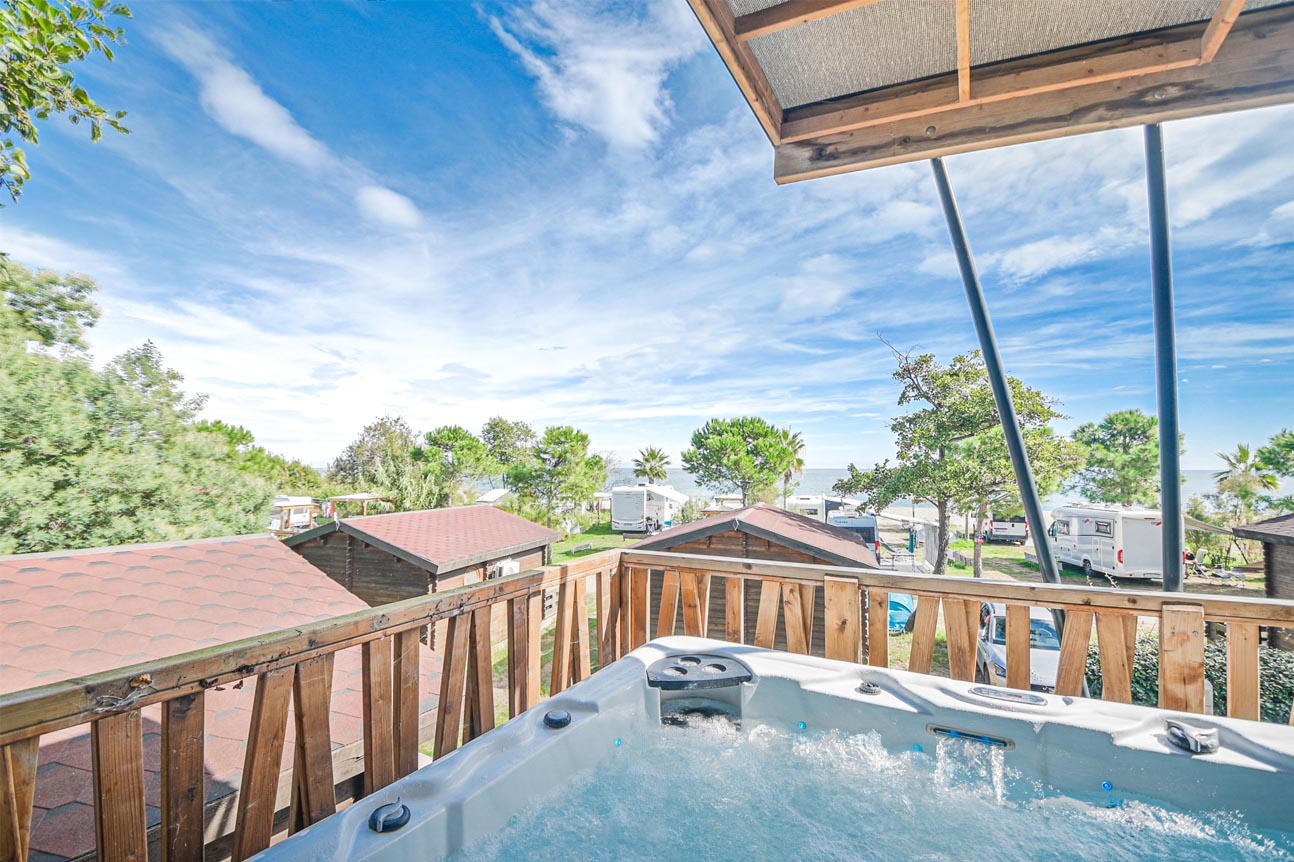
Haute-Corse is undoubtedly an attractive region, attracting many holidaymakers in search of authenticity every year. With its varied landscapes, from beaches to mountains, this département is perfect for camping.
Whether you opt for traditional or modern camping, the Haute-Corse offers numerous sites to pitch your tent or park your motorhome. This guide presents a selection of the region’s finest campsites.
We’ll explore coastal sites overlooking the Mediterranean and campsites in the heart of unspoilt nature. Each site has been chosen for its unique setting and quality facilities. Whether you’re a family, a couple or a group of friends, you’re sure to find the ideal campsite for your vacation in Haute-Corse!
Seaside campsites: between fine sand and turquoise waters
Haute-Corse is renowned for its heavenly beaches and crystal-clear waters. For lovers of swimming and water sports, staying at a seaside campsite is a great option. Here we present a selection of the region’s finest coastal campsites.
Camping de la Plage in Calvi
Located just a stone’s throw from Calvi’s famous beach, this campsite offers direct access to the sea. The pitches, shaded by umbrella pines, allow you to take full advantage of the Mediterranean atmosphere. The campsite also offers comfortable mobile homes for those looking for a little more comfort. The advantages of this campsite are many:
- an ideal location, close to Calvi town center;
- modern facilities, including a swimming pool and children’s play areas;
- a friendly, family atmosphere.
It’s also worth noting that this campsite is particularly appreciated for its cleanliness and the quality of its services. Entertainment in high season helps to create a warm atmosphere appreciated by young and old alike.
Camping U Paradisu in L’Île-Rousse
Nestled in a green setting overlooking the sea, Camping U Paradisu offers panoramic views over the Gulf of L’Île-Rousse. This exceptional site combines the charm of a natural campsite with the comfort of modern facilities. Highlights of this campsite include:
- spacious, well-defined pitches;
- access to a small private cove;
- top-quality facilities, including a beautiful swimming pool with sea views.
What’s more, our proximity to L’Île-Rousse means that campers can easily take advantage of the shops and entertainment on offer in this charming seaside resort. Hiking enthusiasts will appreciate the multitude of hiking trails accessible via the campsite.
These seaside campsites promise a unique experience, combining the pleasures of the beach with those of camping. But for those who prefer the atmosphere of Corsica’s hinterland, there are other equally attractive options!
Inland campsites: immersion in Corsican nature
Thehinterland of Haute-Corse is a real treasure trove for nature lovers. Campsites in these areas offer a different experience, more focused on discovering Corsican mountain landscapes and traditions.
Camping A Casetta in Corte
Located in the heart of Corsica, near Corte, the A Casetta campsite is a haven of peace for nature lovers. Surrounded by mountains, this campsite offers an idyllic setting in which to recharge your batteries and enjoy the wild beauty of the island. The highlights of this campsite are :
- spacious, shaded pitches;
- a nearby river, ideal for cooling off;
- easy access to the hiking trails of Corsica’s regional nature park.
What’s more, the campsite’s central location makes it an ideal base for exploring the island’s interior. Campers can also discover the picturesque villages and immerse themselves in authentic Corsican culture.
Camping Les Oliviers in Ghisonaccia
Despite its proximity to the coast, Camping Les Oliviers offers a typical Corsican hinterland atmosphere. Nestled in a century-old olive grove , it combines rustic charm with modern comforts.
Its assets include pitches shaded by magnificent olive trees, a swimming pool and leisure facilities suitable for the whole family. Not to mention its proximity to the beaches of the eastern coast, helping to maintain a calm, authentic atmosphere.
This campsite is particularly attractive to families looking for peace and quiet, while remaining close to tourist attractions. Campsites in the hinterland offer a different facet of Haute-Corse, far from the hustle and bustle of seaside resorts. They offer an intimate experience, ideal for reconnecting with nature.
Choosing the ideal campsite: criteria and advice
Selecting the perfect campsite for your vacation in Haute-Corse means taking a number of criteria into account. Here are a few tips to help you make the best choice.
Essential criteria
When choosing your campsite, there are several things to consider:
- location: seaside or inland, depending on your preferences;
- Facilities : swimming pool, playground, on-site grocery store, etc. ;
- type of accommodation: bare pitch, mobile home or bungalow;
- Services on offer: entertainment, equipment rental, etc.
It’s important to define your expectations and needs before making your choice. For example, if you’re traveling with your family, a campsite with activities for children will be more suitable. On the other hand, if you’re looking for peace and quiet, a smaller, less busy campsite may be more suitable.
Book at the right time
Haute-Corse is very popular in summer, so book early, especially for popular campsites. For July-August, book early in the year. From May, June or September, 2 to 3 months in advance is sufficient. Contact campsites directly for availability and special offers.
Activities not to be missed during your camping holiday
A camping holiday in Haute-Corse is the ideal opportunity to discover the region’s natural and cultural riches. Would you like to discover a few must-do activities for your vacation? We’ll tell you all about them!
Water sports and seaside activities
Haute-Corse is renowned for its magnificent beaches and crystal-clear waters. Take advantage of the many water sports on offer:
- swimming, of course, in the turquoise waters of the Mediterranean;
- snorkeling, to observe the underwater flora and fauna;
- sea kayaking, ideal for exploring inaccessible coves by land ;
- scuba diving, for the more adventurous.
So many activities to make the most of the exceptional setting offered by the Corsican coast. Don’t forget to ask at your campsite, as many offer equipment rental or partnerships with local service providers.
Discovering the hinterland
The interior of Haute-Corse is full of treasures to discover. Hiking trails, suitable for all levels, invite you to explore picturesque landscapes. Perched villages, witnesses to Corsican Corsican history and culture. Finally, local gastronomy in traditional inns offers an authentic immersion in regional culture.
Conclusion
Haute-Corse is an ideal destination for camping enthusiasts. It offers a variety of sites to suit all tastes. With Corsica Campingdiscover campsites by the sea or in the heart of nature, each with its own unique features.
Would you like to relax on heavenly beaches or explore hiking trails? In either case, the perfect setting for your vacation awaits you in Haute-Corse! What are you waiting for? Book now and enjoy an unforgettable experience in the heart of Corsican beauty?
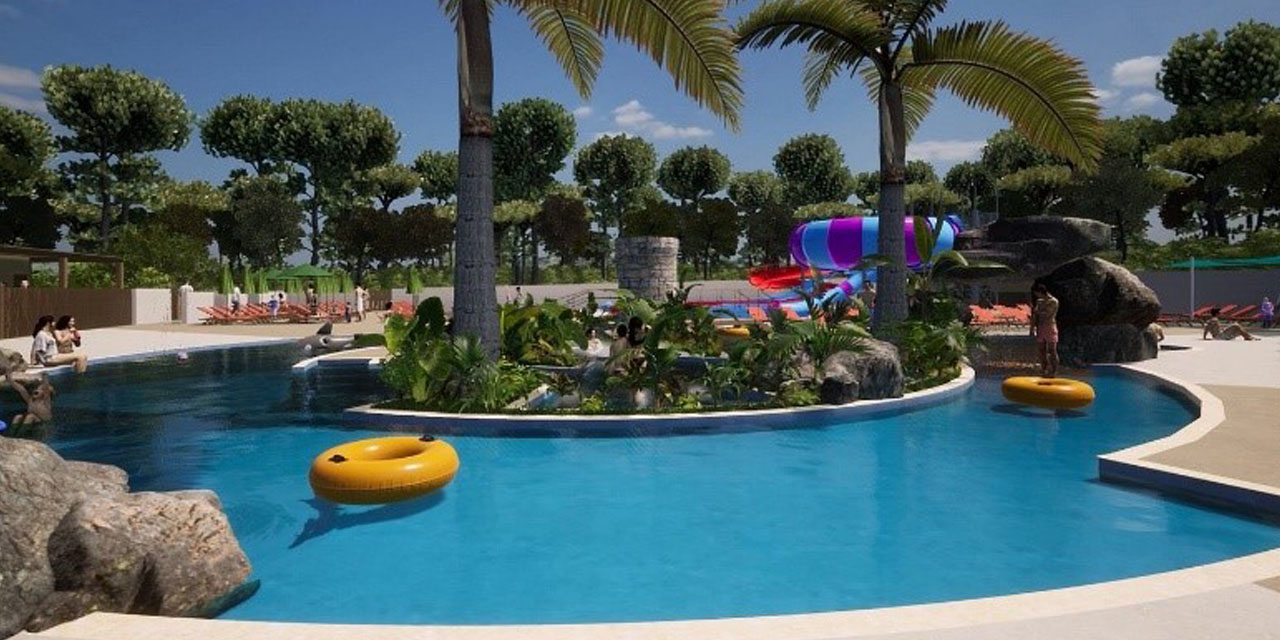
Bella Vista 


Calvi, Balagne
Camping Bella Vista
Description of Camping Bagheera
Camping Bella Vista – A haven of peace in the heart of Calvi.
Camping Bella Vista is a charming 3-star establishment located in Calvi in Balagne on a vast green estate of 6 to 7 hectares where travelers can enjoy a peaceful and flowery environment for their stay.
Its location near the Pinède beach, approximately 900 meters away, and the town center of Calvi makes it a destination of choice for those who wish to combine rest and exploration.
Camping Bella Vista offers a selection of accommodations to suit everyone’s tastes:
Shaded areas are available for classic camping enthusiasts with spacious areas for setting up tents and camping vehicles to fully enjoy the surrounding nature.
Les cabanes et les petites maisons en bois sont également disponibles pour un séjour plus agréable au camping ; Ils sont équipés de tout ce dont vous avez besoin et offrent une terrasse privée avec vue sur la nature environnante.
You can share them as a couple or with friends for a moment of relaxation in the open air.
To ensure a pleasant and fun-filled stay at Camping Bella Vista, several facilities and services are available :
Visitors can enjoy the aquatic facilities including an outdoor swimming pool, a children’s pool and slides for relaxing and fun moments suitable for all ages.
A café is available on site and offers a selection of light snacks and refreshing drinks in a pleasant and friendly atmosphere.
In addition to camping accommodation, you can also enjoy some practical benefits such as free on-site parking, the ability to bring your pets and specially adapted facilities for people with reduced mobility.
If you would like to know about the different campsites that accept dogs, we invite you to visit our partner site.
Camping Bella Vista enjoys an ideal location for exploring the region’s treasures:
Pinède Beach is located just 900 meters away, offering an irresistible invitation to swim and relax in an idyllic setting.
Just a short walk from the main beach is the historic heart of Calvi, which is full of cultural and gourmet activities to discover, including its famous citadel and charming cobbled streets.
Balagne offers a multitude of picturesque villages to discover, as well as hiking trails and magnificent natural landscapes that immerse visitors in the heart of the splendor of Corsica.
By choosing Camping Bella Vista, holidaymakers are guaranteed an experience combining convenience and immersion in nature while enjoying a friendly and warm atmosphere.
Activities near the campsite
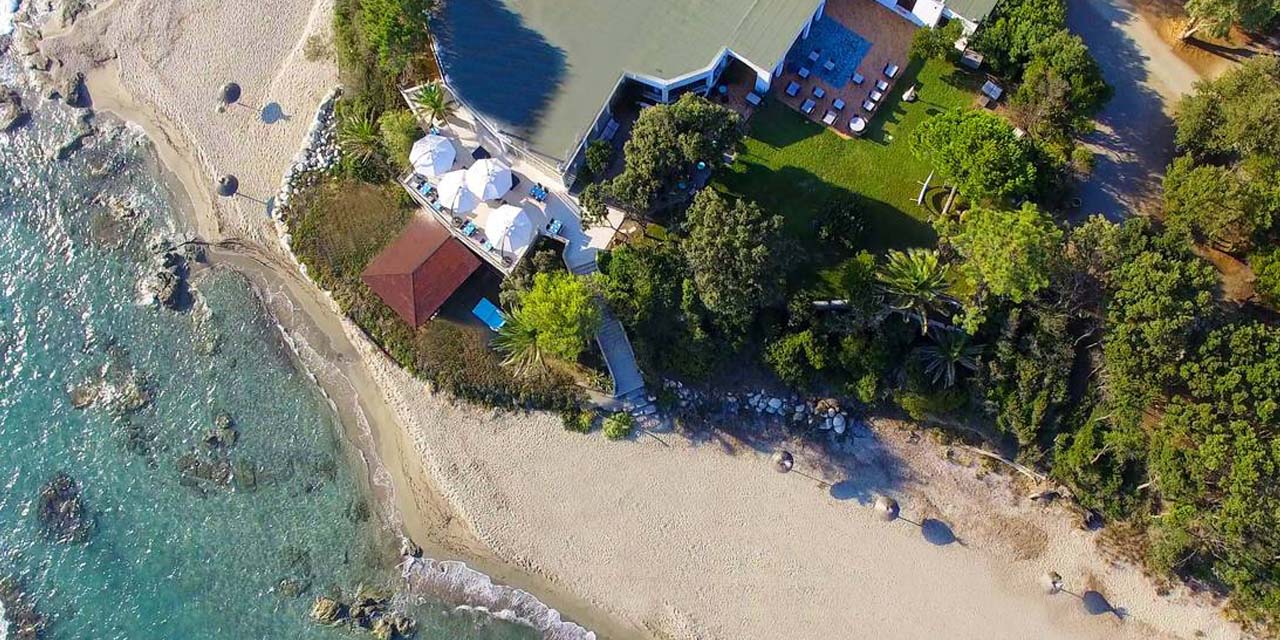
Bagheera 


Bravone, Eastern Coast
Camping Bagheera
Description of Camping Bagheera
A preserved and authentic coastal landscape.
Camping Bagheera is located in Bravone in Haute-Corse and is a luxury four-star campsite offering an exceptional setting between the sea and a green and refreshing eucalyptus forest.
This naturist campsite stretches across 60 hectares of unspoiled nature and provides direct access to a 5 km long private beach with crystal-clear waters where you can fully recharge your batteries. Perfect for lovers of tranquility and open spaces offering breathtaking views of beautiful Corsica while benefiting from high-end amenities for a pleasant stay.
Its ideal location makes it a strategic point for exploring the surrounding area and exploring the surroundings in their entirety.
Accommodation options to suit everyone
Camping Bagheera offers various types of accommodation to suit everyone’s preferences and requirements.
Holidaymakers can choose between shaded pitches for tents and caravans or opt for more comfortable rentals such as wooden chalets or fully equipped villas that can accommodate up to 6 people.
Each type of accommodation is carefully designed to ensure a pleasant stay in a setting close to the beach and campsite facilities.
The calm atmosphere and the exceptional natural setting ensure a relaxing experience in complete harmony with nature.
A diverse range of services and varied activities.
To ensure a most pleasant stay at the campsite, it offers a range of varied services: a restaurant offering delicious dishes cooked with fresh local ingredients; a grocery store full of basic necessities; and a relaxation area with sauna and massages for a guaranteed well-being break.
You can enjoy a wide range of activities on site or nearby such as hiking or water sports; scuba diving; yoga and aquagym; as well as bicycle and kayak rentals to explore the surrounding area freely.
Camping Bagheera is available from April to October and is the perfect place to enjoy an exceptional experience combining comfort and nature on the Isle of Beauty.
If you would like to book one of our partner campsites and take advantage of great deals, don’t wait any longer, visit our partner site.
Activities near the campsite
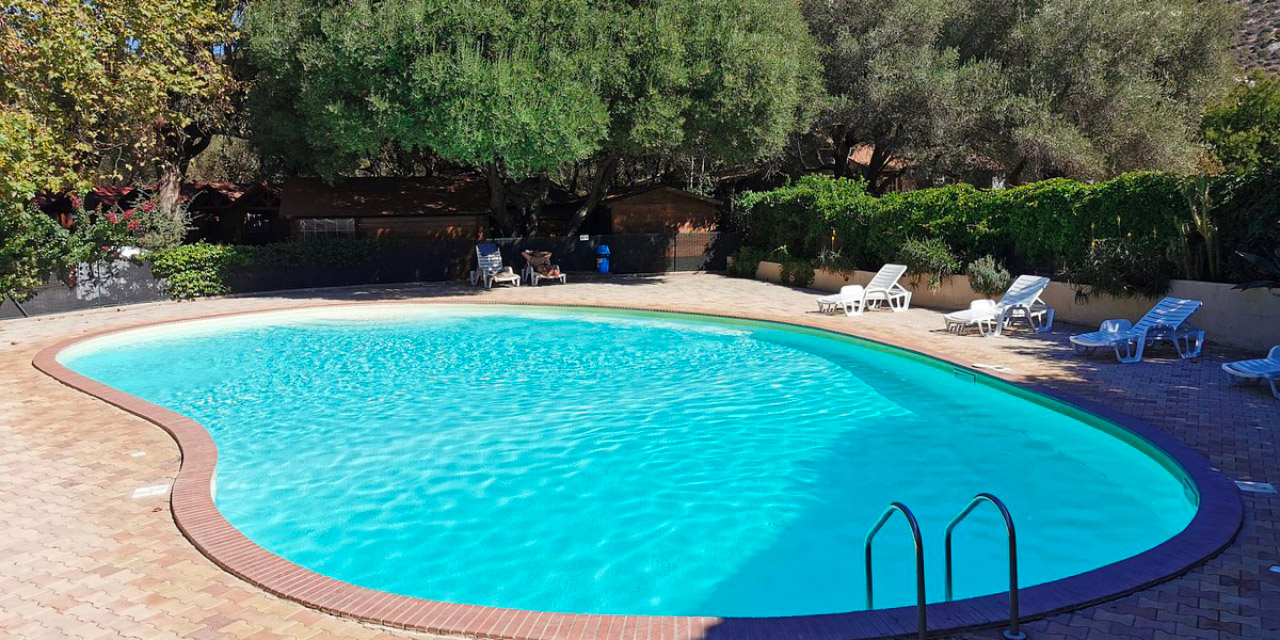
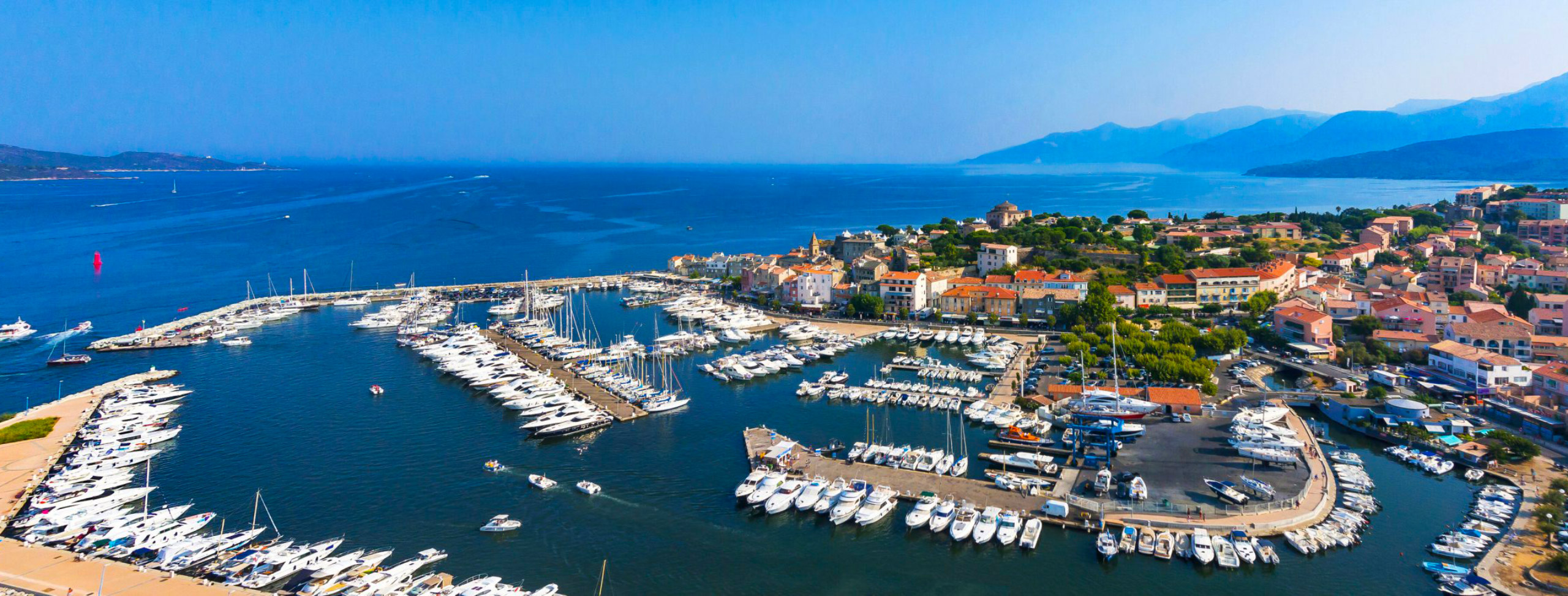
Camping d’Olzo 


Saint-Florent, Bastia region

500m from the sea

Outdoor swimming pool

Pizzeria
Olzo campsite in Saint-Florent, rated 3 stars
Camping Corse Olzo is a 3-star campsite nestled in Saint-Florent, Haute-Corse.
Its privileged location just 2 kilometers from the heart of the village and a stone’s throw from the beach means you can easily explore the wonders of the surrounding region, whether it’s the unspoilt sandy beaches of the surrounding area, the Agriates desert with its customs trail for a pleasant hike, or a wine-tasting getaway to Patrimonio, renowned for its AOC (appellation d’origine contrôlée) vineyards.
A warm and friendly atmosphere
Camping Saint Florent
Olzo offers you a peaceful and authentic stay, ideal for holidays with family or friends in a natural and serene environment.
The owners have developed this site while respecting its ecosystem with the proximity of century-old olive trees and lush vegetation such as mimosas and eucalyptus trees.
The spacious and shaded pitches offer optimal comfort while inviting you to fully enjoy the tranquility of the place with quality Corsican camping services.
The locations are clearly defined, and the harmonious presence of greenery ensures an authentic experience in a calm and peaceful environment. Superb Corsican mobile homes are at your disposal!
Camping Themes

Camping by the sea
500m from the beach

Snack Bar
Tea or Coffee

Outdoor swimming pool
More comfort

Restoration
Pizzeria

Pets allowed
Dog spaces

Camping pitches
For tent, caravan or camper van
Useful information
Website
www.campingolzo.com
Campsite opening
April 18th to October 5th
Number of locations
65
Number of rentals
27
Languages spoken at reception
French
German
English
Campsite address
1170 Rue des Goumiers Marocains
20217 SAINT-FLORENT
GPS
42.693582,9.326695
Getting there by plane
Bastia Poretta Airport – — km
Calvi Airport – — km
Ajaccio Napoléon Bonaparte Airport – — km
Getting there by boat
Ferry – Port of Bastia – — km
Ferry – Port of Île Rousse – — km
Services
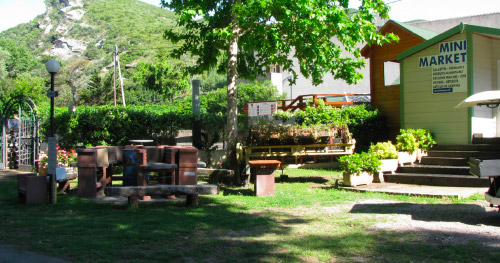
Services
- • Wifi access
- • Collective barbecues
- • Disabled toilets
- • Restaurant (From 05/15 to 09/15)
- • Bar (From 05/15 to 09/15)
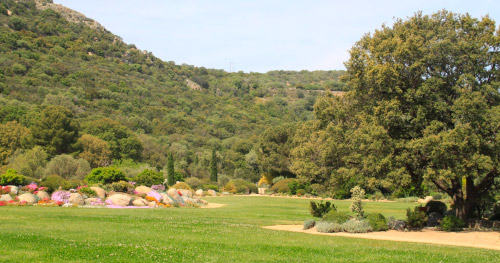
Sports & Leisure
- • Outdoor swimming pool (From 05/15 to 09/15)
- • Sea
- • Playground
- • Table tennis
- • Petanque ground
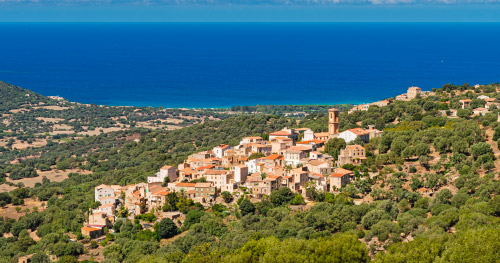
In the surrounding area
- • Grocery store
- • Hiking
- • Canyoning
- • Boat rental
- • Jet Ski
Additional information
Camping d’Olzo welcomes visitors from April 20th to September 20th and offers a variety of nearby leisure activities to fully enjoy !
Discover the splendid Corsican beaches that line the surrounding area or opt for hiking in the areas around Saint-Florent and Cap Corse; ideal for exploring the beauty of Corsica in complete freedom while enjoying optimal comfort and essential services for a successful stay.
Location of the campsite
Activities near the campsite
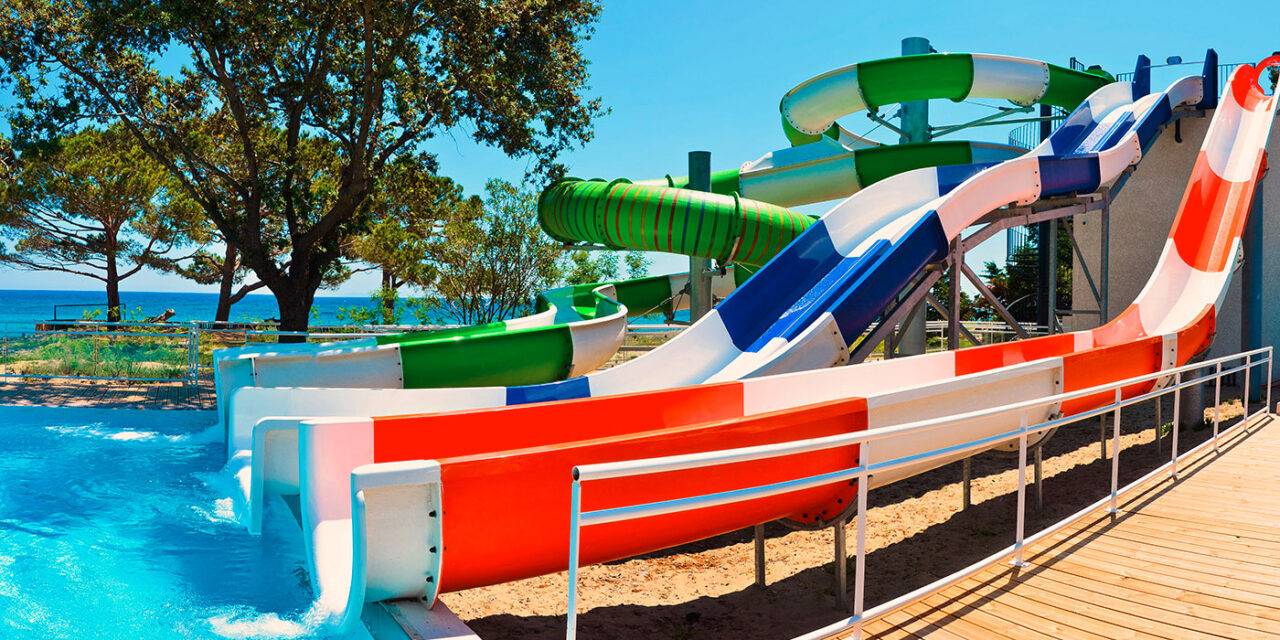
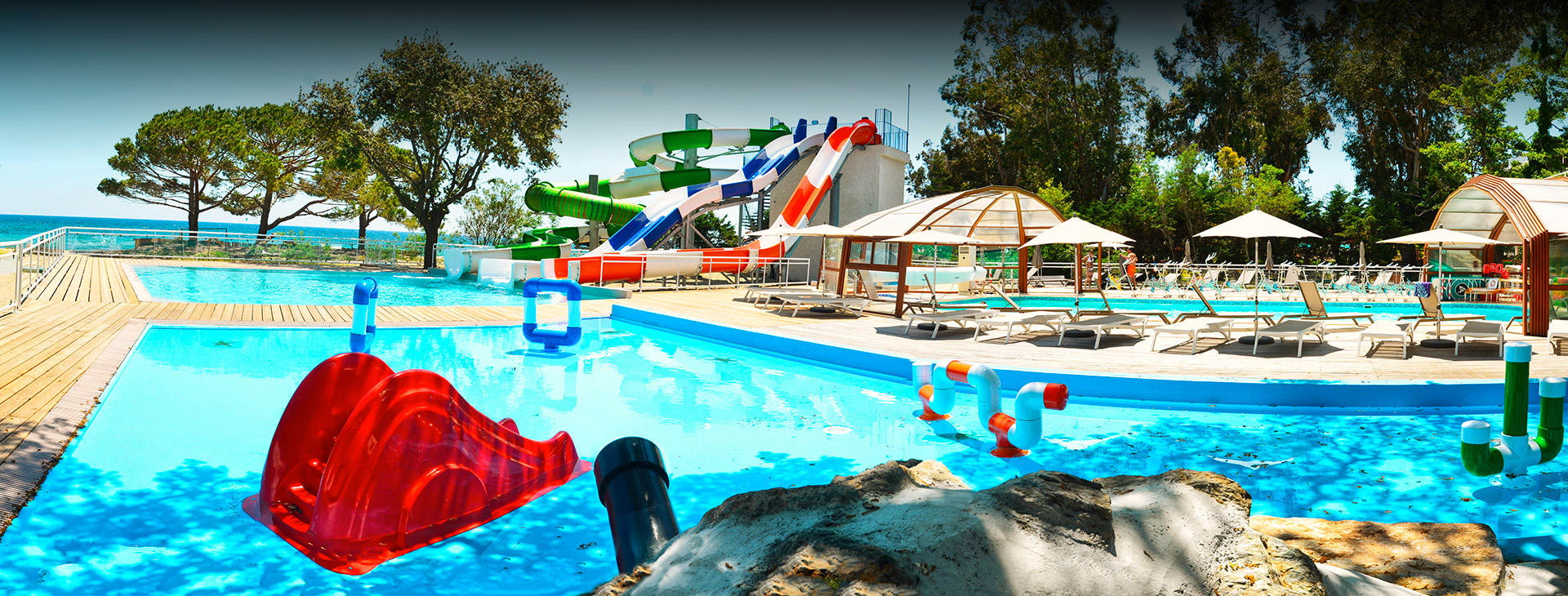
Camping Merendella 



Moriani, The Eastern Coast

Direct access to the beach

Slides and Games

Entertainment & Evenings
Presentation of Camping Merendella
This 4-star Corsican campsite is ideally located in a forest of alders and oaks on more than 7 hectares with 300 meters of seaside. You will find a swimming pool with sea view, a private beach with free deckchairs at your disposal, two bars restaurants and entertainment.
Each camper pitch is a minimum of 80M² which will allow you to have a large living space, even with your vehicle on the pitch.
As for camping rentals, you have a wide choice whether you want to be by the sea or on the mountain side, or have a privileged location. Each rental has its own private parking space.
You will find more information directly on the Camping website.
Camping Themes

Camping by the sea
Direct access to the beach

Water park
Slides and games

Heated swimming pool
More comfort

Campsite with entertainment
Organized events

Restoration
Restaurant, bar and ice cream parlor

Camping pitches
For tent, caravan or camper van
Useful information
Website
www.merendella.com
Opening of the campsite
April 1st to October 31st
Number of locations
112
Number of rentals
108
Languages spoken at reception
French
German
English
Address of the campsite
Moriani Plage
20230 SAN NICOLAO
GPS
42.0228635,8.5135104,9
Getting there by plane
Aéroport Bastia Poretta – 9 km
Aéroport Calvi – 99 km
Aéroport Ajaccio Napoléon Bonaparte – 133 km
Getting there by boat
Ferry – Port de Bastia – 32 km
Ferry- Port d’Île Rousse- 77 km
Services
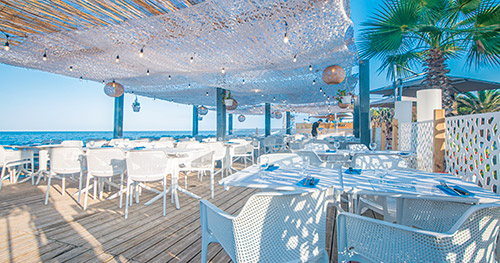
Services
- • Welcome drinks
- • Wifi access
- • Collective barbecues
- • Disabled toilets
- • Restaurant
- • Bar
- • Glacier
- • Deckchair
- • Beach umbrella
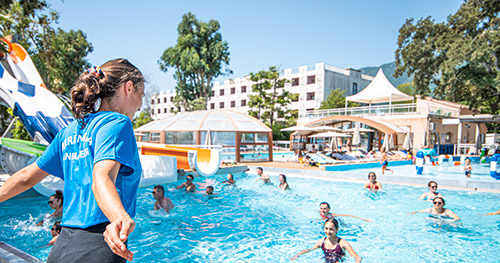
Sports & Leisure
- • Covered and heated swimming pool
- • Slides, paddling pool
- • Jacuzzi
- • Sea
- • Sauna
- • Solarium
- • Gym
- • Kayak, Paddle at sea
- • Beach volleyball, soccer and water basketball
- • Acrobatic trampoline
- • Water Polo
- • Aperitif games
- • Children’s club show
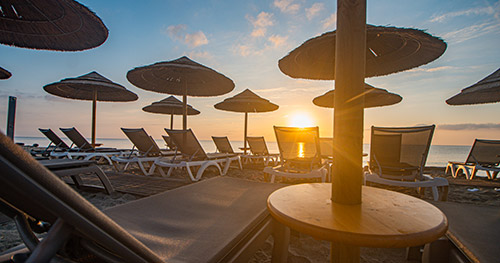
In the surrounding area
- • Grocery store
- • Hiking
- • Canyoning
- • Boat rental
- • Jet Ski
- • Towed buoy
Prices and Availability
Location of the campsite
Activities near the campsite
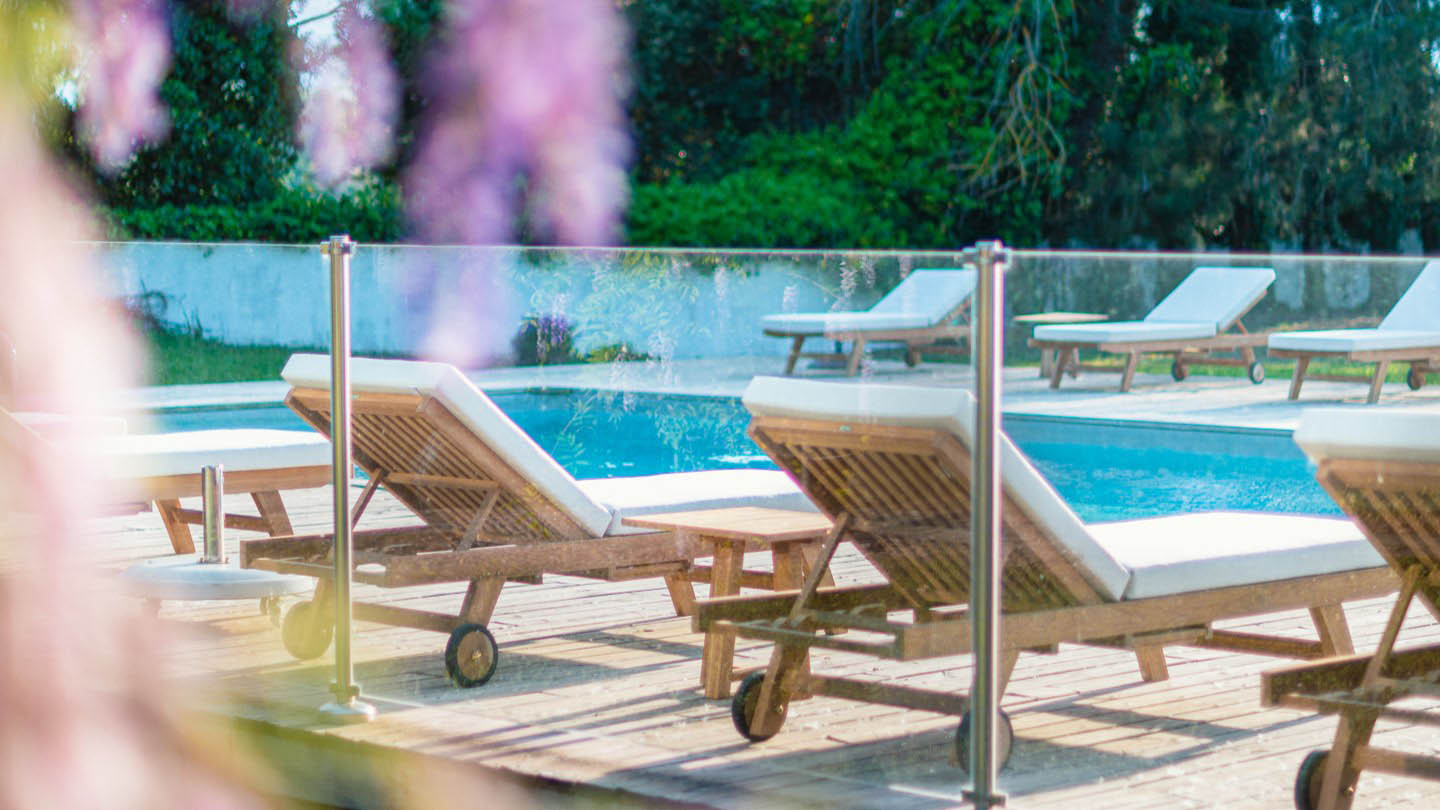
Map of campsites in Corsica: Dive into the heart of an island paradise between sea and mountains in Northern Corsica! This breathtaking region is a veritable playground for outdoor enthusiasts and adventurers in search of escape. Imagine breathtaking landscapes: wild beaches, secret coves and hilltop villages offering an unforgettable camping experience.
With a multitude of options spread across the country, finding the perfect spot can seem daunting. But don’t worry! Our comprehensive guide and campsite map will help you find the perfect spot, whether you’re looking for nature, tranquility or adventure. Get ready for a memorable stay in the heart of this exceptional setting!
The different camping zones in Northern Corsica
With its enchanting landscapes and varied services, Northern Corsica offers motorhome sites for everyone. Quiet mountains, lively coastal areas or family getaways, each region offers a unique experience. Let’s explore the treasures of Cap Corse and Balagne for an unforgettable holiday.
Cap Corse campsites: between sea and mountains
A veritable jewel case of nature, Cap Corse captivates visitors with its wild and unspoilt character. This authentic region, often nicknamed “the island within the island”, offers the perfect setting for lovers of contrasting landscapes. Campsites located along the coast offer the chance to take full advantage of pebble or fine sand beaches. They offer :
- a serene atmosphere, ideal for recharging your batteries;
- spectacular locations, some with sea and mountain views ;
- well-kept infrastructures, such as small restaurants and relaxation areas.
What’s more, this region is the ideal starting point for hikers wishing to explore the steep paths of Cap Corse. For example, the famous Route des Crêtes offers breathtaking views of the Mediterranean. Please note that in high season, these campsites can fill up quickly. That’s why we recommend making a reservation.
Staying in this area also gives you the chance to visit villages such as Nonza or Centuri, which capture the authentic charm of Corsica. An experience combining cultural discovery and communion with nature.
Balagne and its family campsites
Balagne, with its lush green landscapes and fine sandy beaches, is an ideal destination for families looking for comfort and conviviality. This region, located between Calvi and L’Île-Rousse, offers a wide range of campsites suitable for all ages. The region’s infrastructure is designed to meet the needs of families:
- swimming pools, some heated, for sunny days ;
- safe play areas for children;
- a wide range of events, from creative workshops to evening dances.
What’s more, its proximity to local shops and markets makes daily life easier, making it a pleasant stay for all. Another major advantage of the Balagne region is its access to idyllic beaches. Some areas in particular are ideal for water sports activities such as paddling or scuba diving. For example, the beaches of Alga and Ghjunchitu are in the immediate vicinity of the campsites, offering the perfect combination of relaxation and leisure.
For those wishing to explore further, the hilltop villages of Sant’Antonino and Pigna are a must. These places, rich in history and crafts, offer an authentic insight into local culture. Staying at a campsite in this region offers a vacation that combines relaxation, discovery and immersion in Corsican heritage.
Criteria for choosing a campsite
Choosing the right campsite in Corse du Nord means taking into account a number of essential aspects. From location to facilities and general atmosphere, every detail counts for a successful stay (for example, campsites with a water park). Whether you’re a lover of the seaside, mountain adventures or unusual experiences, these criteria will help you find the ideal place for your vacation.
Location and type of campsite
The location of the campsite is one of the first factors to be taken into account to guarantee a pleasant stay. In Northern Corsica, there are a variety of possibilities to satisfy very different desires. If you want to make the most of the beaches, opt for a seaside campsite. You’ll have easy access to creeks and sandy beaches, ideal for swimming and lounging.
For lovers of nature and wide open spaces, mountain campsites offer a unique experience. In addition to a cooler, shadier setting, these sites are ideal for activities such as hiking and climbing. Some campsites are even strategically located to offer exceptional panoramic views of the mountains or the sea.
What’s more, there are campsites that combine the two environments and are located at a reasonable distance from beaches and remote areas. This type of location allows you to vary your pleasures by enjoying both marine and land activities. Last but not least, choose accommodation that matches your expectations: a modern mobile home, a traditional tent or an unusual dwelling such as a wooden bungalow. The most important thing is to choose a comfortable setting in harmony with the environment.
Services and equipment
The quality of services and facilities plays a decisive role in the comfort and satisfaction of your stay. Well-maintained sanitary facilities, for example, are a fundamental criterion, especially for families or tourists traveling in groups. In addition, a Wi-Fi connection can be appreciated, whether for planning your activities or sharing your time with loved ones.
What’s more, some campsites in Northern Corsica offer additional services that can make all the difference. For example, they offer bicycle parking, so that tourists can explore the surrounding area without having to take the car. There are also shuttles to beaches and tourist sites, to help avoid parking constraints in high season.
For families, the presence of children’s clubs orsupervised activities is a real plus. These facilities enable youngsters to have fun in complete safety, while giving parents a little time to relax. Last but not least, catering facilities such as small restaurants and snack bars add a touch of conviviality. The icing on the cake is that some campsites offer a warm and welcoming atmosphere, with themed evenings and entertainment to create unforgettable memories.
Practical tips for a successful camping holiday
Camping in Northern Corsica means immersing yourself in unspoilt nature and enjoying breathtaking scenery. To make the most of this experience, it’s essential to be well-prepared to understand the island’s specific features and camping requirements. Discover our tips for combining comfort, safety and respect for this unique environment.
Must-have items
Preparing your camping holiday in Northern Corsica means choosing equipment suited to the climate and natural setting. If you opt for a camper van or tent, choose equipment that is wind-resistant and easy to set up. This is because there are certain areas, especially at altitude, where tourists may be exposed to sea breezes. A comprehensive first-aid kit is also essential, particularly in view of the high daytime temperatures and the presence of insects in certain regions.
Don’t forget that, even in summer, temperatures can plummet at night, especially in mountainous areas. So pack warm evening clothes and a good sleeping bag for a good night’s sleep. You’ll also need a headlamp or lantern for night-time travel. What’s more, a reusable water bottle and hiking boots are invaluable allies, especially if you’re offering escapades on Corsican trails.
Respect the environment and local regulations
Corsica is a natural treasure that deserves to be protected. For this reason, you need to adopt responsible gestures to limit your impact on this fragile ecosystem. To this end, campsites generally have specific areas for sorting waste. What’s more, campfires are strictly regulated, or even prohibited, in many areas to prevent fires.
Ask campsite managers about the conditions to be met before taking action. Beyond that, it is advisable to use portable stoves for safe cooking, as these are hazardous to the environment. In protected areas, avoid disturbing local wildlife or picking plants, as some species are endemic and under protection.
Focus on eco-friendly campsites in Northern Corsica
More and more campsites in Northern Corsica are adopting eco-responsible practices to minimize their environmental impact. These establishments favor the use of sustainable materials for the construction of their infrastructures. This ensures that they blend harmoniously into the natural landscape. They also implement efficient resource management systems, such as waste reduction and water saving, to preserve the local ecosystem.
What’s more, these campsites often work with local producers to offer food that is more respectful of the environment. Staying in these establishments therefore offers the opportunity to enjoy a more authentic experience close to nature. It’s an ideal way to combine relaxation, adventure and ecological commitment during your stay.


